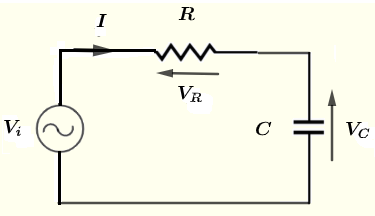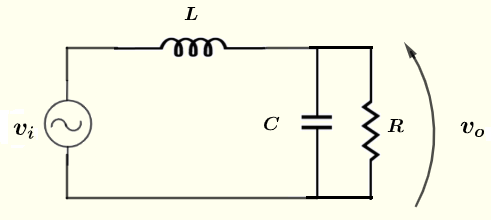
Kirchhoff's and Ohm's law is extended and used to solve AC circuits problems using impedances in complex forms.
All the quantities such as voltages, currents and impedances are represented by complex numbers in standard and polar forms.
The imaginary unit is defined by \( j = \sqrt {-1} \) or \( j^2 = - 1 \)
A complex number \( Z \) in the standard the form \( Z = a + j b \) may be written in polar form as
\[ Z = r \; \angle \; \theta \]
where \( r \) and \( \theta \) are the modulus and argument , of \( Z \), respectively and are defined by
\[ r = |Z| = \sqrt {a^2 + b^2} \; \text{and} \; \theta = \arctan \left( \dfrac{b}{a} \right) \; \text{within the range} \; -\pi \lt \theta \le \pi \]
It is easier to divide or multiply complex numbers in polar form
Let \[ Z_1 = r_1 \; \angle \; \theta_1 \; \text{and} \; Z_2 = r_2 \; \angle \; \theta_2 \]
\[ Z_1 \cdot Z_2 = r_1 \cdot r_2 \; \angle \; \theta_1 + \theta_2 \]
\[ \dfrac{Z_1}{Z_2} = \dfrac{r_1}{r_2} \; \angle \; \theta_1 - \theta_2 \]
Problem 1
Find the magnitude and phase shift (polar form) of the current through and voltages across the resistor \( R \) and the capacitor \( C \) in the circuit below given that the voltage source \( v_i = 10 \cos (\omega t ) \) V, the resistances \( R = 100 \; \Omega \), \( C = 0.47 \; \mu F \), frequency \( f = 1 \) kHz and \( \omega = 2 \pi f \).

Let \( V_i \), \( V_R \) \( V_C \) and \( I \) be the complex forms of \( v_i \), \( v_R \) \( v_C \) and \( i \) respectively.

Problem 2
Find the magnitude and phase shift (polar form) of the voltage \( v_o \) in the circuit below given that the voltage source \( v_i = 10 \cos (\omega t ) \; V \), the resistances \( R = 100 \; \Omega \), \( C = 0.47 \; \mu F \), \( L = 300 \; mH \) frequency \( f = 2 \) kHz and \( \omega = 2 \pi f \).

Let \( I \), \( V_i \) and \( V_0 \) be the complex forms of \( i \) , \( v_i \) and \( v_o \) respectively \( V_i \) may be written in polar form as follows \[ V_i = 10 \; \angle \; 0 \] The impedances of resistor \( R \) is given by \[ Z_R = R \; \] The impedances of capacitance \( C \) is given by \[ Z_C = - j \dfrac{1}{\omega C} \] Resistor \( R \) and capacitor \( C \) are in parallel. The impedance \( Z \) that is equivalent to \( R \) and \( C \) is given by

\[ Z = \dfrac{Z_R \cdot Z_C}{Z_R + Z_C} \] The inductor \( L \) has complex impedance \( Z_L \) given by \[ Z_L = j \omega L \] Use Kirchhoff's law of voltage around the loop to write the equation \[ V_i - V_L - V_0 = 0 \quad \text{(1)} \] Use Ohm's law to write \[ V_L = Z_L I \quad \text{and} \quad V_0 = Z I \] Substitute \( V_L \) and \( V_0 \) by their expression in equation (1) \[ V_i - Z_L I - Z I = 0 \] Solve for \( I \) \( I = \dfrac{V_i}{ Z_L + Z} \) Use Ohm's law to write \[ V_o = Z I = \dfrac{Z}{ Z_L + Z} V_i\] Substitute by knwon quantities to find numerical values \[ \omega = 2 \pi f = 2 \pi \cdot 2000 = 4000 \pi \] \[ Z_R = R = 100 \] \[ Z_C = - j \dfrac{1}{\omega C} = - j \dfrac{1}{4000 \pi \cdot 0.47 \cdot 10^{-6}} = - 169.314 j \] \( Z = \dfrac{R \cdot Z_C}{R + Z_C} \) ( (\( R \) and \( C \) in Parallel ) \[ = \dfrac{100 \cdot (- 169.314 j)}{100 - 169.314 j } = 74.138 -43.787 j\] and \[ Z_L = j \omega L = 4000 \pi \cdot 300 \cdot 10^{-3} j = 3769.911 j \] \[ V_o = \dfrac{Z}{ Z_L + Z} V_i \] \[ = \dfrac{Z}{ Z_L + Z} V_i \] \[ = \dfrac{74.138 -43.787 j}{ 3769.911 j + 74.138 -43.787 j} V_i \] Simplify \[ = (-0.01135 -0.02012 j) V_i \] Write the complex number \( (-0.01135 -0.02012 j) \) in polar form and substitute \(V_i \) by its values in polar form given above. \[ = ( 0.02310 \angle -119.43^{\circ} ) (10 \; \angle \; 0) \] Simplify \[ V_o = 0.23 \; \angle \; -119.43^{\circ} \]
Problem 3
Find the magnitude and phase shift (polar form) of the voltage \( v_o \) in the circuit below given that the voltage source \( v_i = 10 \cos (\omega t ) \; V \), the resistances \( R_1 = 220 \; \Omega \), \( R_2 = 2.2 \; k\Omega \), \( R_3 = 1 \; k\Omega \), \( C_1 = 0.47 \; \mu F \), \( C_2 = 1.5 \; \mu F \), \( L = 30\; mH \) frequency \( f = 2.5 \) kHz and \( \omega = 2 \pi f \).

Let \( I_1 \), \( I_2 \), \( I_3 \), \( V_i \) and \( V_0 \) be the complex forms of \( i_1 \) , \( i_2 \), \( i_3 \) , \( v_i \) and \( v_o \) respectively. \( V_i \) may be written in polar form as follows \[ V_i = 10 \; \angle \; 0 \] \( V_o \) may be calculated using Ohm's law \[ V_o = R_3 I_3\] We therefore need to calculate \( I_3 \). Let us group the impedances, as shown in the circuit below, such that \[ Z_1 = R_1 \] \[ Z_2 = \dfrac{R_2 ( - \dfrac{1}{\omega C_1} j)}{R_2 - \dfrac{1}{\omega C_1} j} \] ( \( C_1 \) and \( R_2 \) are in parallel) \[ z_3 = R_3 + j \omega L - \dfrac{1}{ \omega C_2} j \] ( \( C_2 \), \( L \) and \( R_3 \) are in series)

Problem 4
Given \( v_i = 10 \angle 0^{\circ} \) , \( R = 200 \; \Omega \), \( C = 0.47 \; \mu F \), \( L = 40 \; mH \) , frequency \( f = 1 \) kHz,
find the current \( I \) through and the voltage \( V_0 \) across the inductor in complex forms.

Answer to Problem 4
Answer: \( I = 0.047 \angle -47.84^{\circ}\) , \(V_0 = 11.38 \angle 42.16^{\circ} \)
Problem 5
Given \( v_i = 10 \angle 0^{\circ} \) , \( R_1 = 100 \; \Omega \), \( C = 0.47 \; \mu F \), \( R_2 = 120 \; \Omega \), \( R_3 = 200 \; \Omega \), \( R_4 = 400 \; \Omega \), \( L = 20 \; mH \) , frequency \( f = 2 \) kHz,
find the currents \( I_1 \), \( I_2 \) , \( I_3 \) and the voltages across each resistor in complex forms.

Answer to Problem 5
Answers
Currents: \( I_1 = 0.054 \angle 10.55^{\circ} \; , \; I_2 = 0.048 \angle 23.01^{\circ} \; , \; I_3 = 0.013 \angle -42.22^{\circ} \)
Voltages: \( V_{R_1} = 5.49 \angle 10.55^{\circ} \; , \; V_{R_2} = 4.71 \angle -12.32^{\circ} \; , \; V_{R_3} = 2.60 \angle -42.22^{\circ} \; , \; V_{R_4} = 2.77 \angle 15.63^{\circ} \)